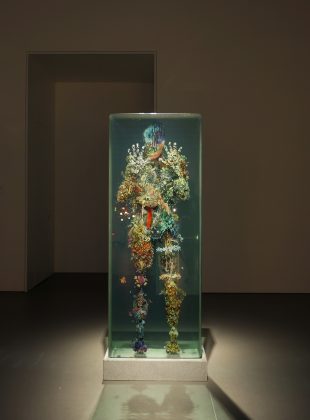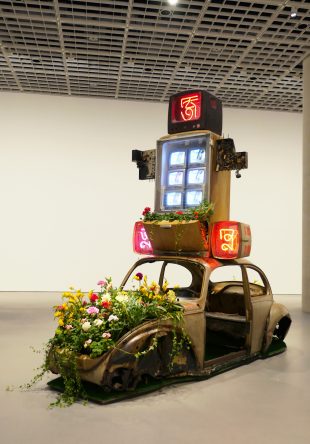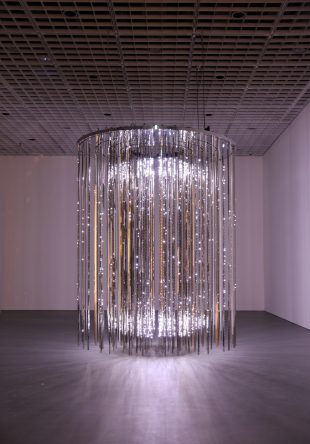
Amorepacific and Art
From February 14 to May 19, the Amorepacific Museum of Art opens its first special exhibition of modern art collection entitled Apma, Chapter One- From The Apma Collection at the Amorepacific headquarters in Yongsan, Seoul. The exhibition features the collection of the Amorepacific Museum of Art, purposefully wide-ranging in genres from painting to photography, sculpture and media art created by artists from Korea and those around the world.
“Through this exhibition, we will present our extraordinary collection of large paintings, photography, sculptures and installation works of modern art bringing together the past and present, and the East and the West. It will be an opportunity to see great artworks from every corner of the globe exploring new perspectives and directions in modern art,” said Moonpil Hyun, Head of the Museum Curatorial Team at the Amorepacific Museum of Art.
The project brings together 40 artworks, placed in eight galleries. Among all the artworks, some of them particularly stand out. For instance, Psychogeographies captures the audience’s attention. The artist, Dustin Yellin, overlaps cultural images to create the shape of a human body. Scanning the detailed images embedded within the sculpture, visitors continuously find new images that transcend the form of human being. The artist has described his process as the “captured and frozen dynamism of culture”. Born in California in 1975 and raised in Colorado, Dustin Yellin is a visual artist living and working in New York. In 2012, he founded Pioneer Works in Red Hook, Brooklyn. Through a broad range of educational programs, performances, residencies, and exhibitions, Pioneer Works transcends disciplinary boundaries to foster a community where alternative modes of thought are activated and supported. Pioneer Works strives to make culture available to all.
In the fifth gallery, Nam June Paik’s artwork merges the contrasting forms of humans and machines. A member of Fluxus, the international avant-garde art group of the 1960s, the artist is famous for his video sculptures. Considered the father of video art, Nam June Paik pioneered the use of televisual electronic media in art. In fact, he created numerous robots composed of television sets, produced a synthesizer that allowed him and others to manipulate electronic imagery in real-time, and made the first video collages with found imagery. Coining the term “the electronic superhighway,” Paik imagined a world in which human beings near and far would be connected through radio waves and television broadcast channels—in many ways predicting the internet. In the exhibition, visitors can see Marco Polo, an installation inspired by the thirteenth-century Italian merchant who traveled through the East, overcoming many obstacles to live a truly nomadic life.
Cylinder, a LED sculpture created by Leo Villareal, is one of the most outstanding artworks of the exhibition. For this work, about 160 LED lamps were attached to stainless steel poles. The lights shine, dim, and shift according to a program, thus generating abstract patterns. The hypnotic spread and convergence of the tiny units of light eventually take on the form of a complex organism. Leo Villareal’s artworks usually combine LED lights and encoded computer programming to create illuminated displays. Villareal’s work is in the permanent collections of many museums including the Albright-Knox Art Gallery, Buffalo, NY; The Museum of Modern Art, New York, NY; Naoshima Contemporary Art Museum, Kagawa, Japan; Nerman Museum of Contemporary Art, Overland Park, KS, and the National Gallery of Art, Washington, D.C.
Almost at the end of the exhibition, the audience can see Inside me, an art piece created by the American artist and filmmaker Doug Aitken. Defying definitions of genre, he explores every medium, from film and installations to architectural interventions. With a rough, rocky surface enclosing a segmented mirror, Inside Me seems to generate condensed energy, due to the stark contrast between the materials. With its fragmented reflections of the surroundings, this work resembles a kaleidoscope, continuously showing dynamic movement even as it embodies stillness and the stoppage of the time.
Apma, Chapter One- From The Apma Collection is a huge exhibition that offers food for thought. In fact, through different media, visitors can take a break from the hustle and bustle of city life, and reflect on contemporary issues such as the concept of femininity (Dorothy, Joana Vasconcelos), North Korean society and rules (Pyongyang VI, Andres Gursky), gender roles in China (More or less the same, Lin Tianmiao), and many more. Moreover, thanks to the exhibition guide app, APMA GUIDE, visitors can enjoy audio interpretations recorded by a curator, high-definition images, and online links related to each artwork.






